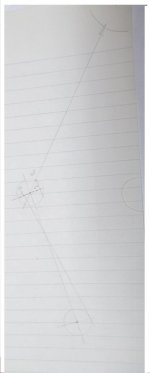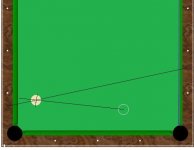Easy Fractional Aiming system in a nutshell
This is a simple way to get fractions of the ball and use them as an aiming system. I'll use a thick cut to the right and a thin cut to the left to show the method.
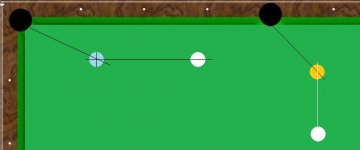
Stand behind the center of both balls. Draw a line from the pocket through the center of the object ball. The point where the line cuts the circumference is the overlap point (OvP) and is used to start the method. Fig A
Drop a line down from the OvP to the horizontal aiming line. Fig B

Divide the line from center ball to the edge into quarter sections to assist estimating the fraction. It can be divided into 8 or 16 sections to gain more accuracy. This is the 'scale' to get your fraction number. If you have more numbers on your ruler you can measure smaller lengths more accurately.
For clarity the example will use 8 sections. Number the ball with 0 at center ball to 8 at the edge. Read the number off the scale at the point where the lines cross. Fig C
In the example it's almost 2. 2 of 8 sections is 2/8 or 1/4. This the fraction used to aim with. Subtract the fraction from 1.0 to get the ball overlap, in the example it's 3/4. The 1/4 is used for aiming, the 3/4 overlap is just a name or label.
To use the fraction, extend the scale across the entire ball. Use the same division length. This will put 16 units across the whole ball. Each division is now 1/16 ball.
This is a cut to the right so start with 0 at the right edge of the ball, 8 at center ball and 16 at the other edge. For right cuts the numbers run backwards on the ball. Fig D.
Find the fraction on the scale. 1/4 = 4/16 so find 4 units from the edge towards the center and aim the right edge of the CB at it.
FYI - You may find it easier to keep the original 2/8 and just double it to 4/16 instead. This has the advantage of finding a mid position easier. If a fraction reading was 2.5/8 for example, it's easy to convert to 5/16.
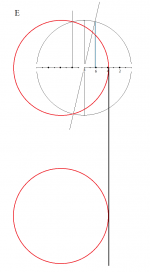
The red CB on the bottom has the right edge aimed at the 1/4 whole ball fraction - the 4 position. Stroke the shot so the edge of the CB follows the line to the overlap position at the top.
.
For left cuts the numbers will be normal across the whole ball but backwards for reading the OvP position on half ball. Fig F shows a cut to the left. I used one diagram to show the aiming process and another to show the overlap position.
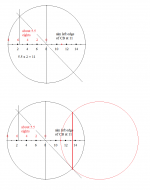
Start:
The numbers in red are used to find the aiming fraction. Notice the numbers run backwards. We're looking for the distance from center ball to the point directly below the OvP. Zero at the center with 8 on the edge to find the fraction.
Double the number and find it's position on the black numbers. With a left cut the zero is on the left edge. Aim the left edge of the CB at the 11 position.
End:
Simple fractions in a nutshell. SimpFracts
FYI - The red vertical line from the ball intersection cuts the equator where the contact points collide.
.
Some tips and cautions:
Ya don't need no stinkin' fractions. You can think of the divisions as 'ticks'. The shot in Figs. A-E is a 2 to 4 ticker, the left cut is a 5.5 to 11 shot.
Keep it simple when you start. Put the OB about 1 or 2 diamonds away from the pocket with the CB 2 diamonds from the OB. Just use half of the table at first. If/when things click, try more separation between the CB and OB. Later, move the OB farther from the pocket.
Since the CB is closer to you and appears bigger for long shots, it may be easier to use the CB to get the fraction instead of the OB. Draw a line from the OvP parallel to the OB - CB center line until it crosses the CB at the equator. Put the 'scale' on the CB and read the fraction.
The good and bad:
It's more flexible to use than some systems because you're not tied to the center of the pocket. This makes aiming at the side pockets easier because you can aim to avoid the 'ears'. The line to the pocket fixes the fraction with the OvP. There's no grid layout to learn, zones to worry about or special CB ball numbers.
The bad news is the system is coarse when used with 8ths. All fractional systems are. There's a lot of angles between the ticks. Try to estimate to the 1/4 tick for better accuracy.
I was searching google playing with some OvP trig when I ran across a link to preview a book about fractional overlaps. I was curious to see the method used to calculate them. I was surprised the system was so cumbersome. I had already been playing with the OvP as a concept and saw a way to use it to quickly find the fraction with a lot less overhead. As a result I've spent far too much time on the subject and working with Windows Paint.
Have fun with the system.
This is a simple way to get fractions of the ball and use them as an aiming system. I'll use a thick cut to the right and a thin cut to the left to show the method.

Stand behind the center of both balls. Draw a line from the pocket through the center of the object ball. The point where the line cuts the circumference is the overlap point (OvP) and is used to start the method. Fig A
Drop a line down from the OvP to the horizontal aiming line. Fig B

Divide the line from center ball to the edge into quarter sections to assist estimating the fraction. It can be divided into 8 or 16 sections to gain more accuracy. This is the 'scale' to get your fraction number. If you have more numbers on your ruler you can measure smaller lengths more accurately.
For clarity the example will use 8 sections. Number the ball with 0 at center ball to 8 at the edge. Read the number off the scale at the point where the lines cross. Fig C
In the example it's almost 2. 2 of 8 sections is 2/8 or 1/4. This the fraction used to aim with. Subtract the fraction from 1.0 to get the ball overlap, in the example it's 3/4. The 1/4 is used for aiming, the 3/4 overlap is just a name or label.
To use the fraction, extend the scale across the entire ball. Use the same division length. This will put 16 units across the whole ball. Each division is now 1/16 ball.
This is a cut to the right so start with 0 at the right edge of the ball, 8 at center ball and 16 at the other edge. For right cuts the numbers run backwards on the ball. Fig D.
Find the fraction on the scale. 1/4 = 4/16 so find 4 units from the edge towards the center and aim the right edge of the CB at it.
FYI - You may find it easier to keep the original 2/8 and just double it to 4/16 instead. This has the advantage of finding a mid position easier. If a fraction reading was 2.5/8 for example, it's easy to convert to 5/16.

The red CB on the bottom has the right edge aimed at the 1/4 whole ball fraction - the 4 position. Stroke the shot so the edge of the CB follows the line to the overlap position at the top.
.
For left cuts the numbers will be normal across the whole ball but backwards for reading the OvP position on half ball. Fig F shows a cut to the left. I used one diagram to show the aiming process and another to show the overlap position.

Start:
The numbers in red are used to find the aiming fraction. Notice the numbers run backwards. We're looking for the distance from center ball to the point directly below the OvP. Zero at the center with 8 on the edge to find the fraction.
Double the number and find it's position on the black numbers. With a left cut the zero is on the left edge. Aim the left edge of the CB at the 11 position.
End:
Simple fractions in a nutshell. SimpFracts
FYI - The red vertical line from the ball intersection cuts the equator where the contact points collide.
.
Some tips and cautions:
Ya don't need no stinkin' fractions. You can think of the divisions as 'ticks'. The shot in Figs. A-E is a 2 to 4 ticker, the left cut is a 5.5 to 11 shot.
Keep it simple when you start. Put the OB about 1 or 2 diamonds away from the pocket with the CB 2 diamonds from the OB. Just use half of the table at first. If/when things click, try more separation between the CB and OB. Later, move the OB farther from the pocket.
Since the CB is closer to you and appears bigger for long shots, it may be easier to use the CB to get the fraction instead of the OB. Draw a line from the OvP parallel to the OB - CB center line until it crosses the CB at the equator. Put the 'scale' on the CB and read the fraction.
The good and bad:
It's more flexible to use than some systems because you're not tied to the center of the pocket. This makes aiming at the side pockets easier because you can aim to avoid the 'ears'. The line to the pocket fixes the fraction with the OvP. There's no grid layout to learn, zones to worry about or special CB ball numbers.
The bad news is the system is coarse when used with 8ths. All fractional systems are. There's a lot of angles between the ticks. Try to estimate to the 1/4 tick for better accuracy.
I was searching google playing with some OvP trig when I ran across a link to preview a book about fractional overlaps. I was curious to see the method used to calculate them. I was surprised the system was so cumbersome. I had already been playing with the OvP as a concept and saw a way to use it to quickly find the fraction with a lot less overhead. As a result I've spent far too much time on the subject and working with Windows Paint.
Have fun with the system.
Last edited:
